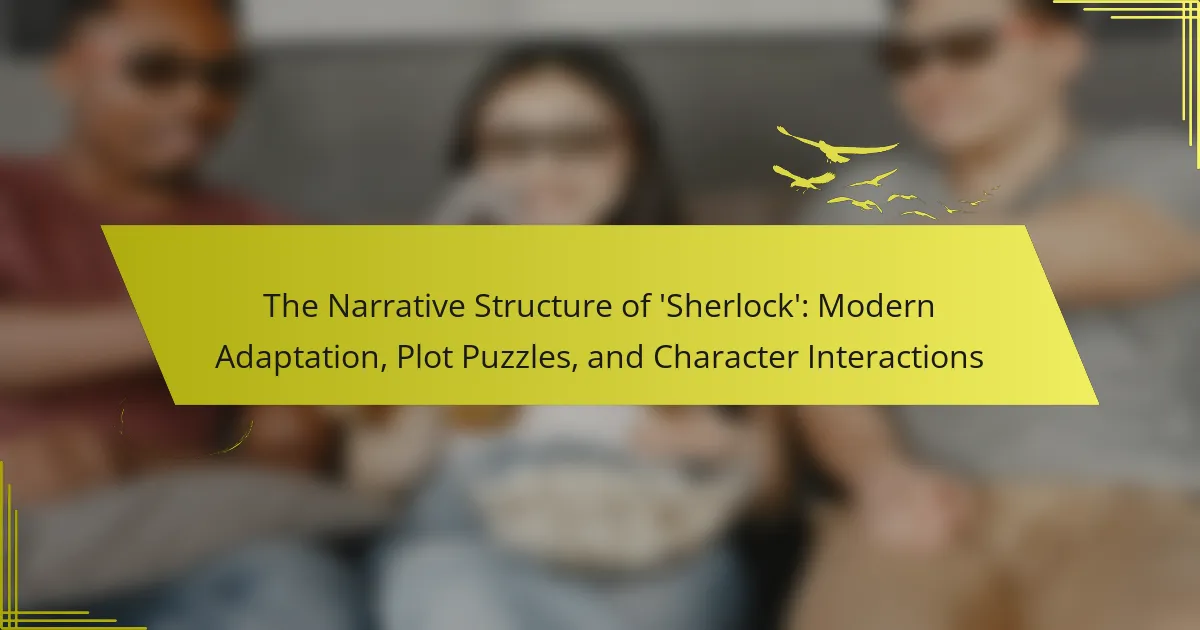The article examines the narrative structure of the television series ‘Sherlock,’ which adapts classic Sherlock Holmes stories into a contemporary format. It highlights the series’ use of a non-linear timeline, flashbacks, and character interactions to enhance plot development and viewer engagement. Each episode presents a self-contained mystery while contributing to overarching themes and character arcs. The integration of modern technology and the dynamic relationship between Holmes and Watson are emphasized as key elements that redefine traditional storytelling for a modern audience. Overall, the article provides insights into how these narrative techniques contribute to the series’ critical acclaim and popularity.

What is the narrative structure of ‘Sherlock’?
The narrative structure of ‘Sherlock’ follows a contemporary episodic format. Each episode adapts a classic Sherlock Holmes story into a modern setting. The series employs a mix of linear and non-linear storytelling. Flashbacks are frequently used to provide context and deepen character development. Each episode typically centers around a central mystery that Holmes must solve. Character interactions are crucial for plot progression and emotional depth. The relationship between Holmes and Watson is central to the narrative. The series also includes overarching themes and character arcs that span multiple episodes. This structure enhances viewer engagement and allows for intricate plot development.
How does ‘Sherlock’ adapt the traditional detective narrative?
‘Sherlock’ adapts the traditional detective narrative by modernizing the setting and characters. The series places Sherlock Holmes in contemporary London, using technology and social media as integral plot devices. This adaptation allows for real-time problem-solving and communication. The character of Watson is reimagined as a blog writer, providing a narrative voice and perspective. The episodic structure incorporates complex plots that challenge viewers, while maintaining classic whodunit elements. Additionally, the show explores character relationships and psychological depth, enhancing the narrative complexity. By blending traditional elements with modern storytelling techniques, ‘Sherlock’ reinvents the detective genre for a new audience.
What are the key elements of the classic detective story in ‘Sherlock’?
The key elements of the classic detective story in ‘Sherlock’ include a brilliant detective, a faithful companion, and a complex mystery. Sherlock Holmes serves as the brilliant detective, showcasing exceptional observational skills and deductive reasoning. Dr. John Watson is the faithful companion, providing support and narration throughout the stories. The complex mystery often involves a crime or puzzle that requires unraveling. Clues are meticulously presented, leading to a logical resolution. Additionally, there is usually a significant antagonist who challenges Holmes. The stories also feature an atmospheric setting, often in Victorian London. These elements combine to create engaging narratives that have captivated audiences.
How does ‘Sherlock’ modernize these elements for contemporary audiences?
‘Sherlock’ modernizes classic elements by integrating technology and contemporary social issues. The series employs smartphones and the internet, reflecting modern communication methods. This adaptation allows for real-time problem-solving and information retrieval, enhancing the narrative’s pace. Character interactions are updated to include more diverse perspectives and relationships. The portrayal of Sherlock Holmes incorporates traits such as social awkwardness, making him relatable to today’s audiences. Additionally, the show addresses themes like mental health and societal norms, resonating with current viewers. This blend of traditional storytelling with modern contexts ensures relevance and engagement with contemporary audiences.
What role do plot puzzles play in ‘Sherlock’?
Plot puzzles in ‘Sherlock’ serve to engage the audience and drive the narrative forward. These puzzles create suspense and intrigue, compelling viewers to actively participate in solving the mystery. Each episode features complex plot twists that challenge both the characters and the audience. The use of deduction and logical reasoning is central to Sherlock Holmes’ character, reflecting Arthur Conan Doyle’s original works. Moreover, plot puzzles enhance character development by revealing their motivations and relationships. The resolution of these puzzles often leads to significant revelations and emotional payoffs. This structure keeps the audience invested in the storyline, making each episode a captivating experience. Overall, plot puzzles are essential to the narrative framework of ‘Sherlock’, ensuring a blend of entertainment and intellectual challenge.
How are plot puzzles introduced in each episode?
Plot puzzles in each episode of ‘Sherlock’ are introduced through intriguing scenarios that present a mystery. These scenarios often involve a crime or unusual event that captures the audience’s attention. Key characters, such as Sherlock Holmes and Dr. John Watson, are typically introduced alongside the plot puzzle. The initial setup creates suspense and prompts viewers to engage in solving the mystery. Clues are gradually revealed throughout the episode, allowing for audience participation in deduction. The narrative structure often includes red herrings to mislead viewers, enhancing the complexity of the plot puzzle. Each episode culminates in a resolution that ties together the introduced elements, providing a satisfying conclusion. This method of introduction keeps the audience invested in the storyline and character dynamics.
What techniques does ‘Sherlock’ use to engage viewers with its plot puzzles?
‘Sherlock’ employs several techniques to engage viewers with its plot puzzles. The series uses non-linear storytelling to create suspense. Flashbacks reveal critical information at strategic moments. Visual elements, like on-screen text, illustrate Sherlock’s thought process. This technique invites viewers to solve puzzles alongside the characters. The show incorporates red herrings to mislead the audience, enhancing the challenge. Strong character development adds emotional investment, making the resolution more satisfying. Clever dialogue and interactions between characters enrich the narrative, keeping viewers intrigued. Each episode culminates in a complex solution that rewards attentive viewers.
How do character interactions shape the narrative in ‘Sherlock’?
Character interactions are central to shaping the narrative in ‘Sherlock.’ The dynamic between Sherlock Holmes and Dr. John Watson drives the plot forward. Their contrasting personalities create tension and collaboration. Holmes’ analytical nature complements Watson’s emotional intelligence. This interplay reveals character depth and motivations. Additionally, interactions with secondary characters enrich the storyline. Each character’s relationship with Holmes and Watson adds complexity to the plot. For example, the rivalry with Moriarty heightens suspense and conflict. Overall, character interactions are integral to developing themes and advancing the narrative.
What dynamics exist between Sherlock and Watson?
Sherlock Holmes and Dr. John Watson share a complex dynamic characterized by deep friendship and intellectual partnership. Sherlock often displays aloofness and emotional detachment. In contrast, Watson embodies empathy and emotional intelligence. Their relationship is built on mutual respect and reliance. Sherlock values Watson’s insights and loyalty. Watson, in turn, admires Sherlock’s brilliance and deductive skills. This dynamic creates a balance between logic and emotion. Their interactions often highlight Sherlock’s eccentricity and Watson’s grounding presence. This interplay drives the narrative and enhances character development throughout the series.
How do secondary characters influence the main narrative arc?
Secondary characters significantly influence the main narrative arc by providing conflict, motivation, and depth. They often serve as foils to the protagonist, highlighting key traits and decisions. For instance, in ‘Sherlock’, characters like Dr. Watson and Inspector Lestrade add layers to Sherlock Holmes’ character. Their interactions create tension and drive the plot forward. Secondary characters also contribute to the thematic elements of the story, reinforcing or challenging the protagonist’s beliefs. This dynamic enriches the narrative, making it more complex and engaging. In essence, they are crucial for character development and plot progression.

What are the unique attributes of ‘Sherlock’s narrative structure?
Sherlock’s narrative structure features a non-linear timeline and intricate plot twists. The series employs flashbacks to reveal character motivations and backstories. Each episode presents a self-contained mystery while contributing to overarching themes. Character interactions are layered, showcasing relationships that evolve throughout the series. The use of modern technology enhances the storytelling, making the narrative feel contemporary. Clues are often hidden in dialogue and visual elements, inviting viewer engagement. The structure balances humor with drama, creating a unique tonal blend. These attributes contribute to the series’ critical acclaim and popularity.
How does the use of non-linear storytelling impact the viewer experience?
Non-linear storytelling enhances viewer engagement by creating suspense and intrigue. This structure allows viewers to piece together the plot from various timelines. It encourages active participation, as audiences must connect disparate events. Research shows that non-linear narratives can lead to increased emotional investment. For example, the series “Sherlock” employs this technique effectively. The fragmented timeline keeps viewers guessing and heightens the mystery. This approach can also lead to deeper character exploration. Overall, non-linear storytelling transforms passive viewing into an interactive experience.
What techniques are employed to weave together different timelines?
Non-linear storytelling is a primary technique used to weave together different timelines. This method allows the narrative to jump between past and present. Flashbacks are often utilized to reveal critical backstory. Additionally, parallel editing can create tension by juxtaposing events from different timelines. The use of visual cues, such as color grading, helps differentiate timelines. Voiceovers may provide context or commentary, linking disparate events. This approach enhances character development and plot complexity. The series “Sherlock” effectively employs these techniques to engage viewers and deepen the narrative.
How does non-linear storytelling enhance character development?
Non-linear storytelling enhances character development by revealing character backgrounds and motivations in a fragmented manner. This approach allows for deeper emotional engagement. It creates suspense and curiosity, prompting viewers to piece together narratives. In ‘Sherlock’, the use of flashbacks and non-chronological events enriches character arcs. For instance, viewers learn about Sherlock’s past through disjointed scenes. This technique emphasizes character growth and transformation over time. Research indicates that non-linear narratives can increase audience investment in characters. It encourages viewers to analyze relationships and conflicts more critically.
Why are visual storytelling elements important in ‘Sherlock’?
Visual storytelling elements are important in ‘Sherlock’ because they enhance narrative engagement. The series utilizes visual cues to convey character emotions and themes effectively. For instance, the use of color palettes reflects mood shifts in scenes. Dynamic camera angles create tension and highlight critical plot points. Visual metaphors, such as the recurring imagery of the London skyline, symbolize the characters’ internal struggles. Additionally, visual storytelling aids in the pacing of the narrative. It allows for the seamless integration of complex plot puzzles without excessive exposition. Overall, these elements contribute to a richer viewing experience and deepen audience connection to the characters and story.
What visual techniques are used to convey plot and character emotions?
Visual techniques used to convey plot and character emotions include color, lighting, and camera angles. Color palettes often reflect characters’ moods and themes. For example, warm tones can evoke comfort, while cool tones may indicate tension or sadness. Lighting plays a crucial role in setting the emotional tone. High contrast lighting can create a sense of drama, while soft lighting can evoke intimacy. Camera angles also influence perception. Low angles can portray power, while high angles can suggest vulnerability. These techniques collaboratively enhance storytelling by visually representing emotions and plot developments.
How does cinematography contribute to the overall narrative structure?
Cinematography significantly shapes the overall narrative structure by visually conveying themes and emotions. It employs techniques like framing, lighting, and camera movement to enhance storytelling. For instance, close-ups can reveal character emotions, while wide shots establish context. In ‘Sherlock’, dynamic camera angles reflect the tension and urgency of the plot. The use of color grading influences the mood, aligning with narrative shifts. Moreover, transitions between scenes can guide audience perception of time and space. Research shows that visual storytelling impacts viewer engagement and comprehension. Effective cinematography thus serves as a crucial tool in narrative development.

What insights can be drawn from the narrative structure of ‘Sherlock’?
The narrative structure of ‘Sherlock’ emphasizes a modern adaptation of classic detective stories. It employs a non-linear timeline that enhances suspense. Each episode features complex plot puzzles that engage viewers. Character interactions are central to the narrative, revealing deeper relationships. The use of technology integrates contemporary elements into the storytelling. Flashbacks and deductions create a dynamic viewing experience. This structure allows for intricate storytelling while maintaining accessibility. Overall, ‘Sherlock’ redefines traditional narratives for a modern audience.
How can writers apply ‘Sherlock’s narrative techniques in their own work?
Writers can apply Sherlock’s narrative techniques by utilizing non-linear storytelling. This technique allows for suspense and intrigue, engaging readers through plot twists. Incorporating detailed character development is essential. Sherlock’s characters are multi-dimensional and evolve throughout the story. Writers should also focus on dialogue that reveals character traits and motivations. This method enhances realism and connection with the audience. Additionally, integrating clues and red herrings can create complex plot puzzles. These elements encourage readers to actively participate in solving the mystery. Lastly, strong visual imagery can enhance storytelling. This technique immerses readers in the narrative, similar to the visual style of the Sherlock series.
What best practices can be learned from ‘Sherlock’s plot development?
Effective plot development in ‘Sherlock’ showcases several best practices. First, the series employs intricate plot twists that keep viewers engaged. Each episode reveals layers of mystery, encouraging audience speculation. Second, character development is tightly woven with the plot. Protagonists evolve in response to challenges, enhancing emotional investment. Third, the use of foreshadowing creates anticipation. Subtle hints are placed throughout the narrative, rewarding attentive viewers. Fourth, pacing is carefully managed. Tension builds gradually, ensuring a satisfying climax. Lastly, the integration of humor balances dramatic moments. This combination of elements contributes to a compelling narrative structure.
How can character interactions in ‘Sherlock’ inspire character-driven storytelling?
Character interactions in ‘Sherlock’ can inspire character-driven storytelling by showcasing complex relationships and emotional depth. The dynamic between Sherlock Holmes and Dr. John Watson illustrates contrasting personalities that drive the narrative. Their interactions reveal personal vulnerabilities and ethical dilemmas. This depth creates relatable characters that audiences connect with. The show’s dialogue is sharp and filled with subtext, enhancing character development. Furthermore, conflicts between characters prompt growth and change, essential for engaging storytelling. The layered interactions also provide multiple perspectives, enriching the narrative experience. Overall, ‘Sherlock’ exemplifies how character relationships can be central to storytelling.
The main entity of the article is the narrative structure of the television series ‘Sherlock’. The article provides an overview of how ‘Sherlock’ modernizes classic detective stories through a contemporary episodic format, utilizing both linear and non-linear storytelling techniques. Key elements discussed include the adaptation of traditional narratives, the role of plot puzzles in engaging viewers, and the significance of character interactions, particularly between Sherlock Holmes and Dr. John Watson. Additionally, the article explores how visual storytelling and non-linear timelines enhance character development and viewer experience, offering insights and best practices for writers to apply in their own work.




